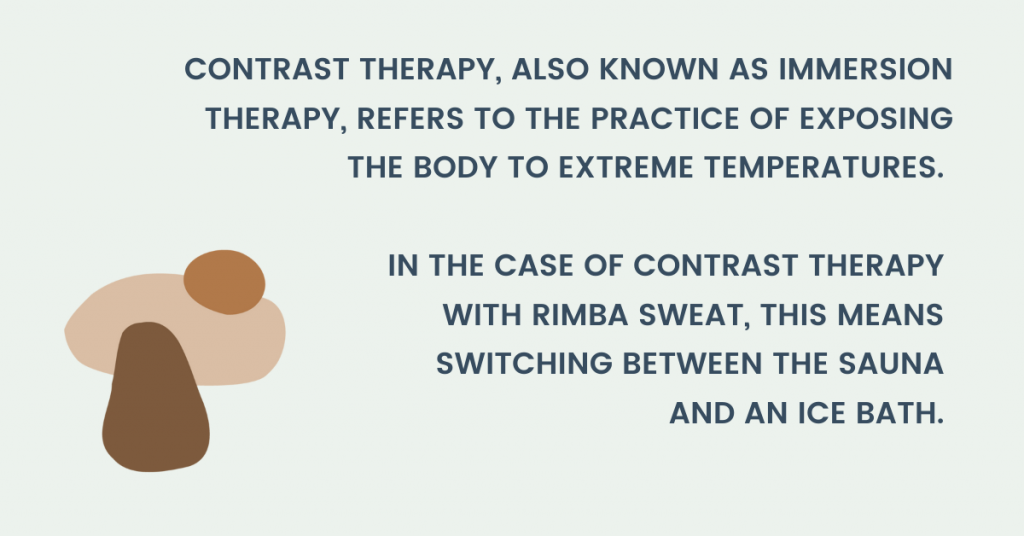Contrast therapy is nothing new – in fact, the practice of moving between hot and cold temperatures to garner different health benefits is something that has been utilised by different cultures for thousands of years. And it makes sense – we know that ice packs and heat packs can do wonders in the case of an isolated injury or pain – imagine what could be achieved if fully immersed in cold water and hot temperatures for a certain period.
The science is there. Athletes swear by it. And more and more health and wellness experts continue to spurt the benefits of hot and cold therapy. So, what is hot and cold therapy? And what does it do?
Rimba Sweat are the latest adopters of contrast therapy and are now offering refreshing sessions right here in Sydney. We’ve put together this guide so that you can better understand why it’s increasing in popularity, and why so many of our clients continue to bang on about the benefits.
Read on to discover everything you need to know about temperature therapy.
What is contrast therapy?
Contrast bath therapy, also known as immersion therapy, refers to the practice of exposing body to different temperatures, for example, hot and cold baths. In the case of hot and cold plunge therapy with Rimba Sweat, this means switching between the sauna and an ice bath to promote blood flow between internal organs.
We provide thermotherapy in the form of a traditional Finnish sauna, ice baths, and pail showers so that you can easily slip between sweating it out and cooling off in your own private oasis.

What is the purpose of contrast therapy?
The purpose is to expose the body to extreme temperature changes, which promotes blood flow and circulation. Across the board, temperature therapy is not used for delayed onset muscle soreness, but for reducing inflammation, pain, and can speed up the muscle recovery process.
When you submerge your body in cold water, vasoconstriction occurs. This process involves your capillaries (small blood vessels) becoming smaller in response to the cold. The exact opposite occurs when you are in warm or hot water. Your body goes through vasodilation, which means your blood vessels slowly open again.
As a result, the changes in blood vessels also change how fast your heart beats. Cold water increases your heart rate, while hot water slows it down.
It is so successful as the cycle from cold to hot water creates a pulsing or pumping action throughout your body, allowing your body to increase blood flow faster, which is what can help with pain and inflammation management.
What kind of temperatures are involved in contrast therapy?
If you’re worried about the extreme temperatures, rest assured, as the temperatures are safe and manageable when undertaking contrast bath therapy. Sure, it takes a little bit of time to get used to willingly sitting in an ice bath – but it is definitely worth it.
The ice water can get as cold as 10 degrees, and the sauna can heat up to 45 degrees*
Safety & effectiveness of contrast therapy
So, does immersion therapy work? And is it safe?
Both valid questions. Yes, immersion therapy has been proven to be effective – there are boundless studies that prove the contrast in temperatures improves both soreness and recovery much more effectively than passive resting.
And yes, this therapy is extremely safe. If temperature changes are something you know would make you uncomfortable or deter you from hot and cold therapy, it may be helpful to know that it is incredibly safe.
When you choose Rimba Sweat for temperature therapy, you can be assured that you are in good hands.
When is contrast therapy used?
As mentioned earlier, cold water immersion therapy is a widespread practice for athletes recovering from specific injuries or as a part of their training and recovery routine. As it targets inflammation of soft tissues, muscle spasms and painful limbs, anyone suffering from inflammation, pain, or discomfort will find relief after participating in hot and cold therapy. It is also great for those who have arthritis and acute injuries.
However, temperature therapy can be utilised by anyone that is interested.
What are the benefits of contrast therapy?
There are many great benefits to hot and cold therapy. Here are the main benefits of practicing this therapy with Rimba Sweat:
Improve circulation:
Due to the cycles of hot and cold temperatures and the promotion of changing blood flow, a pump-like action is formed, which improves overall circulation.
Decreased swelling:
The cold temperatures help to ease swelling and inflammation.
Reduced inflammation:
The increased circulation helps to target inflamed soft tissue.
Improvement in muscle strains:
Thermotherapy helps to relieve any muscle strain through the body’s response to the ice bath.
Increased range of motion:
As strained or sore muscles are improved, they can stretch to their full potential easily.

Increased energy & alertness:
The changes in extreme temperature results in your bodily senses are becoming heightened, increasing energy and alertness.
Elevated mood:
As blood is more easily circulated throughout your body, your mood will also naturally elevate, helping you feel energised and fresh for the day.
Weight loss:
During a 45 min session you can burn up to 1000 calories.
Final Thoughts
Temperature therapy is not new, but is fast becoming a widespread practiced activity across athletes, health and wellness enthusiasts, and anyone looking for a refreshing, energising break from their day.
Rimba Sweat are pleased to offer thermotherapy within our new Neutral Bay studio. Complete with a communal Finnish sauna, ice baths, and pail showers, within our Mediterranean-style studio, we’re confident that once you’ve completed your first session with Rimba Sweat, you’ll be back for more. For more information get in touch with Rimba Sweat today.


